Scythe Andy Samurai Master vs. Thermaltake MaxOrb
by Wesley Fink on June 4, 2007 5:00 AM EST- Posted in
- Cases/Cooling/PSUs
Thermaltake MaxOrb
Thermaltake started business in 1999 in Taiwan, and has since become one of the most recognized brands in computer cooling as well as cases. Since 1999 the company has grown into a world-class company with a state-of-the-art testing and R&D facility based in Taiwan. Thermaltake employs 60+ engineers covering each application segment such as Liquid Cooling, Air Cooling, PC Enclosure and Power Supply for main-stream users, high-end solutions, system integrators and industrial applications. Today you will find Thermaltake cooling solutions around the world.
The MaxOrb is the latest in a long line of Thermaltake "orb" coolers. The Orb name was first used in 2000 when Thermaltake launched the Golden Orb cooler for Pentium processors. The name has been revived recently with the MaxOrb cooler, which combines radial fins and heatpipes in a down-facing CPU cooler.
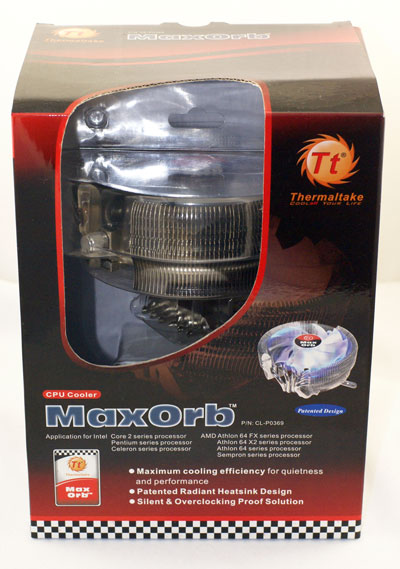
This cooler stands out with distinctive red and black packaging, and the package itself is huge. The MaxOrb and a box of accessories are protected by a plastic clamshell inside the box.
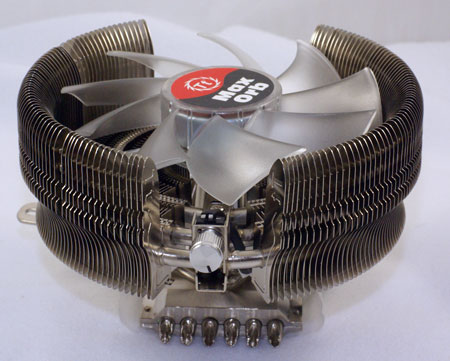
The cooler uses large radial aluminum fins and a large 110mm fan. As you can see there is also a built-in fan speed control that allows fan output to be adjusted up to a claimed 86.5cfm at 2000rpm. The embedded 110mm fan is lit by a blue LED. 110mm is a non-standard fan size, but that is somewhat a moot point since the fan was not designed to be changed.
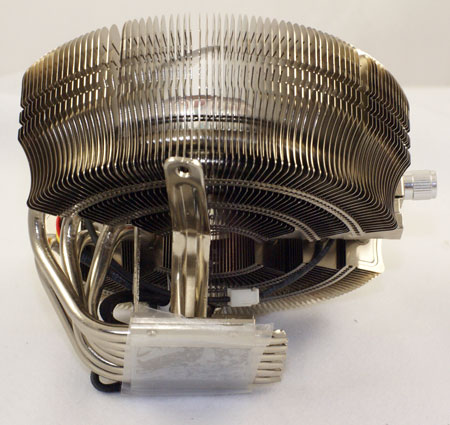
The cooling is further enhanced by six heatpipes extending from the copper base. These turn and pass horizontally through the radial fins to dissipate heat from the processor.
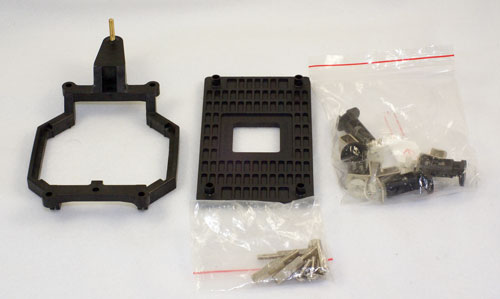
Accessories include mounting brackets for Intel socket 775 and AMD 754/939/940/AM2. The key component is the universal mounting base.
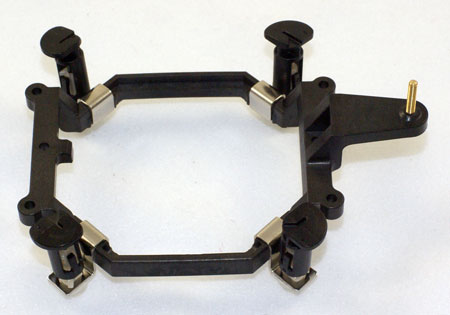
The base attaches the MaxOrb cooler, and four pop-clips slip onto the base for mounting to an Intel socket 775. You don't need to remove the motherboard to mount this cooler.
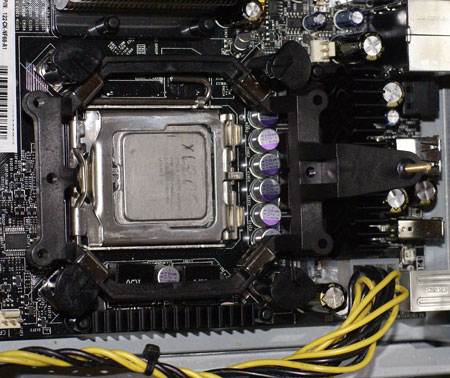
The base pops on first, then the cooler attaches by clipping to the base lug and attaching a single screw. Unlike other coolers that claim simple installation without board removal, this one actually works. The only awkward task is attaching the single screw since there's just no good way on a board mounted in a case to hold the screw while trying to screw it on.
Specifications
Our test system is Intel socket 775, but the Thermaltake MaxOrb will mount on any recent AMD socket as well - including socket 754/939/940 as well as the more recent and AM2. All the needed hardware is included.
The MaxOrb is a big cooler, but it is much shorter than the typical heatsink towers we have been reviewing. The EVGA 680i is a difficult to fit board due to the copper-finned heatsink and fan cooling the Northbridge. It is a snug fit, but the MaxOrb mounted fine on the 680i, the ASUS Striker and ASUS Commando, and on the two new P35 boards - the ASUS P5K Deluxe and P5K3 Deluxe. The P5K3 Deluxe is almost a fit test for any motherboard, since the heatpipes completely circle the CPU socket and connect various cooling heatsinks around the CPU socket. The only precaution on the P5K3 is to mount the MaxOrb with the screw "tongue" over the lower heatpipes near the DIMM sockets. It clears everything in this mount position.
Thermaltake started business in 1999 in Taiwan, and has since become one of the most recognized brands in computer cooling as well as cases. Since 1999 the company has grown into a world-class company with a state-of-the-art testing and R&D facility based in Taiwan. Thermaltake employs 60+ engineers covering each application segment such as Liquid Cooling, Air Cooling, PC Enclosure and Power Supply for main-stream users, high-end solutions, system integrators and industrial applications. Today you will find Thermaltake cooling solutions around the world.
The MaxOrb is the latest in a long line of Thermaltake "orb" coolers. The Orb name was first used in 2000 when Thermaltake launched the Golden Orb cooler for Pentium processors. The name has been revived recently with the MaxOrb cooler, which combines radial fins and heatpipes in a down-facing CPU cooler.

This cooler stands out with distinctive red and black packaging, and the package itself is huge. The MaxOrb and a box of accessories are protected by a plastic clamshell inside the box.

The cooler uses large radial aluminum fins and a large 110mm fan. As you can see there is also a built-in fan speed control that allows fan output to be adjusted up to a claimed 86.5cfm at 2000rpm. The embedded 110mm fan is lit by a blue LED. 110mm is a non-standard fan size, but that is somewhat a moot point since the fan was not designed to be changed.

The cooling is further enhanced by six heatpipes extending from the copper base. These turn and pass horizontally through the radial fins to dissipate heat from the processor.

Accessories include mounting brackets for Intel socket 775 and AMD 754/939/940/AM2. The key component is the universal mounting base.

The base attaches the MaxOrb cooler, and four pop-clips slip onto the base for mounting to an Intel socket 775. You don't need to remove the motherboard to mount this cooler.

The base pops on first, then the cooler attaches by clipping to the base lug and attaching a single screw. Unlike other coolers that claim simple installation without board removal, this one actually works. The only awkward task is attaching the single screw since there's just no good way on a board mounted in a case to hold the screw while trying to screw it on.
Specifications
Our test system is Intel socket 775, but the Thermaltake MaxOrb will mount on any recent AMD socket as well - including socket 754/939/940 as well as the more recent and AM2. All the needed hardware is included.
| Thermaltake MaxOrb Specifications | ||||
| Heatsink | ||||
| Dimensions | 143(L) X 114(D) X 85.2(H)mm | |||
| Weight | 465g (including fan) | |||
| Material | Pure Copper Base and Aluminum Fins | |||
| Heatpipes | Six 6mm copper heatpipes | |||
| Fan | ||||
| Fan Size | 110 mm x 25mm | |||
| Bearing Type | Sleeve Bearing | |||
| Fan Life | 50,000 hours | |||
| Connector | 3-pin with integral fan-speed rheostat, 3.0 Watt Input | |||
| Speed | Silent Mode | 1,300rpm | Low-noise Mode | 2,000rpm |
| Noise Level | Silent Mode | 16.0dBA | Low-noise Mode | 24.0dBA |
| Fan Output | Silent Mode | Low-noise Mode | 85.5cfm | |
The MaxOrb is a big cooler, but it is much shorter than the typical heatsink towers we have been reviewing. The EVGA 680i is a difficult to fit board due to the copper-finned heatsink and fan cooling the Northbridge. It is a snug fit, but the MaxOrb mounted fine on the 680i, the ASUS Striker and ASUS Commando, and on the two new P35 boards - the ASUS P5K Deluxe and P5K3 Deluxe. The P5K3 Deluxe is almost a fit test for any motherboard, since the heatpipes completely circle the CPU socket and connect various cooling heatsinks around the CPU socket. The only precaution on the P5K3 is to mount the MaxOrb with the screw "tongue" over the lower heatpipes near the DIMM sockets. It clears everything in this mount position.










50 Comments
View All Comments
Tuvoc - Monday, June 4, 2007 - link
I'd love to see you guys test this. It is incredibly cheap, yet many claim it to have class-leading performance. Only a proper Anandtech test can reveal the truth... :-)Imnotrichey - Monday, June 4, 2007 - link
I was thinking the same thing. So many sites swear by the Freezer 7 Pro.yacoub - Monday, June 4, 2007 - link
Why does it look like the heatsink is off-center from the base?http://images.anandtech.com/reviews/cooling/2007/s...">http://images.anandtech.com/reviews/coo...ndy-ther...
Is that poor quality manufacturing or by design? I'd be worried about it not evenly drawing the heat away from the CPU core, leaving a hot spot where the heatsink isn't directly over the contact area.
Also curious: Will you guys ever include the numbers for the Arctic Cooling Freezer 7 Pro? It's sort of a mainstay HSF for socket 775 boards and I'm curious how it compares to the hsfs you have tested. It would be nice to know if it'd be worth ~$50-60 to upgrade from my Freezer 7 Pro or if it is already relatively effective compared to the rest of the field.
oldhoss - Monday, June 4, 2007 - link
This one's kinda recent:
http://www.pureoverclock.com/article642-2.html">http://www.pureoverclock.com/article642-2.html
insurgent - Monday, June 4, 2007 - link
How come nobody reviews the Thermalright SI-128 (sites that matter anyways)? I'd like to know how it compares to the other "high-end" heatsinks.Ver Greeneyes - Monday, June 4, 2007 - link
I have a Thermalright XP-90C installed in my PC, and recently I got the novel idea of turning the cooler upside down so that it's pulling air away from my mobo.. and got a significantly lower temperature. Logically, I don't think down-blowing fans mounted on top of a heatsink make sense - the heat from CPU and surrounding components goes into the heatsink, and then you blow it back down at your mobo? I've also found this setup to be very dusty. My XP-90C might just be an anomaly, but I do wonder how other setups will fare with a fan that faces away from the motherboard.PS: another small advantage is that you can't get at the fan-blades on accident with this setup, although they had better not be pressed against the heatsink itself!
xsilver - Monday, June 4, 2007 - link
p1"However, the MaxOrb is still large enough to mount an integral 110mm fan. As yo"
should be internal?
sjholmesbrown - Monday, June 4, 2007 - link
No, integral is the word. Internal would imply the fan was completely enclosed by the cooler (a'la Tuniq tower), integral means the fan is integrated (catch the link) into the cooler, not a separate component.xsilver - Monday, June 4, 2007 - link
in·te·gral(nt-grl, n-tgrl)
adj.
1. Essential or necessary for completeness; constituent: The kitchen is an integral part of a house.
im no english teacher, but I think im right.
integral means essential - of course a fan is essential to a HSF but the meaning in the sentence was to imply that the fan is internal and cannot be removed.
yacoub - Monday, June 4, 2007 - link
Integral is more correct. It's necessary for proper functioning of the device but it's not internal - that would be something completely inside the heatsink.